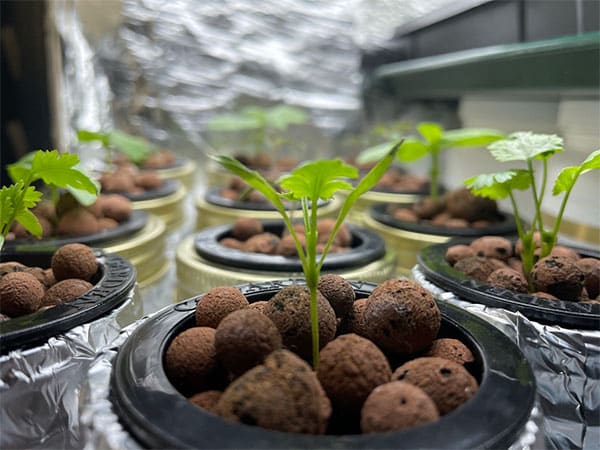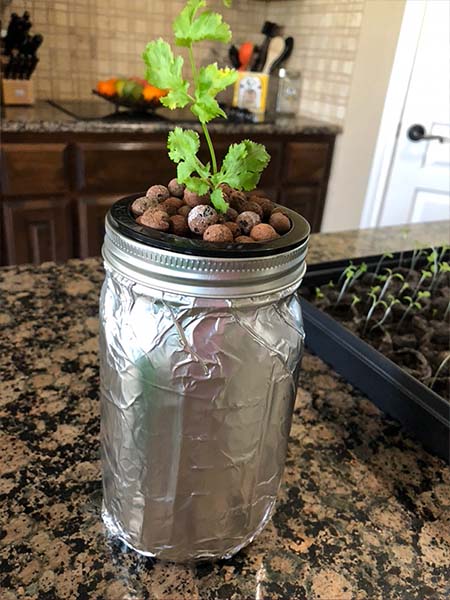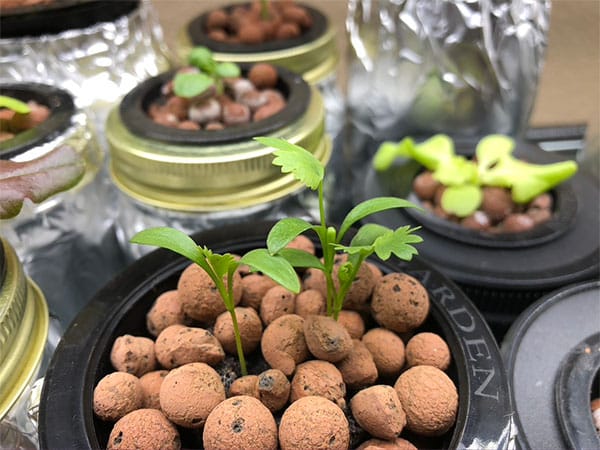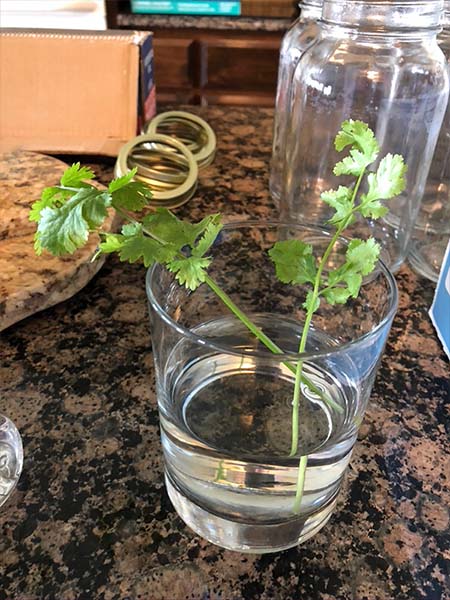Kratky Hydroponic Cilantro
I simply love growing Kratky Cilantro in my hydroponic garden. When I buy cilantro at the grocery store, I rarely use enough before it goes bad. Growing cilantro fresh at home means I have a steady supply of home-grown cilantro whenever I need it. Cilantro is a perfect herb to grow with the Kratky hydroponic method of gardening.
When grown in my Kratky system, cilantro just seems to have much more flavor. I would not say it is stronger, just more flavorful. If you love cilantro, you’ll love growing it in a hydroponic system. The Kratky method is simple perfect for growing cilantro indoors, especially in the winter when you want a fresh harvest.

Young Kratky Cilantro seedlings growing in mason jars in my Kratky hydroponic indoor garden. These were grown from seed and cultivated with the Kratky method of hydroponics.
Kratky Hydroponic Cilantro – Our Favorites for Growing Coriander with the Kratky Method
Advertisement
I bought these CZ net cups and will never buy another brand. They have been used year over year 5+ years.
I love these gro-block rockwool cubes. They keep the rockwool off your hands and soak well.
Before I got these, I used clay pebbles and/or foam cutouts. These fit so much better and block all light.
This is only wishlist. I plan on trying these in the the fall. You can see in my pics I currently use tin foil.
As an Amazon Associate I earn from qualifying purchases.

This is a cloned cilantro cutting that was rooted in a root jar, then transplanted to rockwool. Finally, it was placed in a mason jar filled with nutrient solution and the rockwool covered in clay pebbles. Cloning is a great way to create more cilantro plants quickly.
Cilantro is also known as coriander in some regions. It is an aromatic herb commonly used in culinary dishes for its distinct flavor. Growing cilantro using the Kratky hydroponic method involves a simple and effective way to cultivate this herb without the need for complex equipment or constant monitoring.
Here’s a specific guide on growing cilantro with the Kratky hydroponic method:
- Preparation: Gather the necessary materials including a container (such as a mason jar or a plastic container), net pots, growing medium (such as perlite or clay pellets), nutrient solution, cilantro seeds, and water.
- Container Setup: Fill the container with the nutrient solution, leaving some space at the top. The nutrient solution should contain the necessary nutrients for plant growth. Ensure that the container has a lid to prevent evaporation.
- Planting Seeds: Place the net pots in the container, ensuring that the bottom of the net pots is submerged in the nutrient solution. Plant cilantro seeds in the growing medium within the net pots. Space the seeds according to the recommendations on the seed packet.
- Monitoring: Keep the container in a location with sufficient light, preferably near a window or under grow lights. Check the nutrient solution level regularly and top it up as needed to maintain the appropriate level.
- Maintenance: Monitor the growth of the cilantro plants and ensure that they receive adequate light and nutrients. Trim the plants as needed to promote healthy growth and prevent overcrowding.
- Harvesting: Cilantro can be harvested once the leaves are large enough to use. Harvest the outer leaves first, leaving the inner leaves to continue growing. Regular harvesting encourages bushier growth.
- Replenishing Nutrients: As the plants grow, they will uptake nutrients from the solution. Periodically check the nutrient levels and replenish the solution as necessary to maintain optimal nutrient levels.
- End of Cycle: Cilantro is an annual herb and will eventually reach the end of its growth cycle. Once the plants start to bolt (produce flowers), it indicates the end of the growth cycle. At this point, you can harvest any remaining leaves and start a new batch of cilantro if desired.
The Kratky hydroponic method is a passive system that requires minimal maintenance once set up, making it suitable for growing cilantro and other herbs indoors or in small spaces.


ABOVE: Cilantro cuttings in a glass container filled with water, starting the rooting process. These will be used to create cloned cilantro plants that will grow faster than from seed.
RIGHT: Two cilatro seedlings grown from seed in the hydroponic Kratky garden. You can still see their seedling leaves which have not detached yet. Cilantro can have more than one seedling in your container filled with nutrient solution.
Kratky Hydroponic Basil – Our Favorites for Growing Basil with the Kratky Method
Advertisement
As an Amazon Associate I earn from qualifying purchases.







